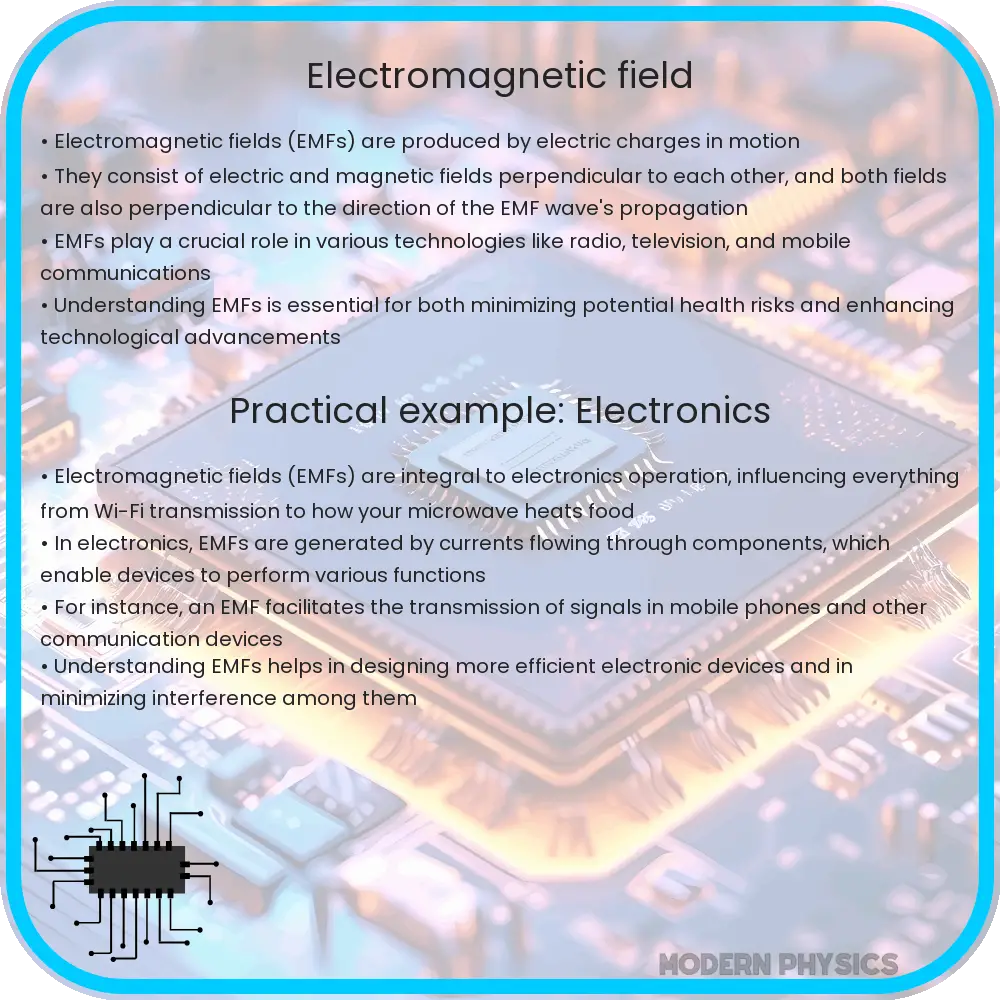Explore the essentials of electromagnetic fields, their impact on technology and health, and their role in advancing scientific theory and applications.

Understanding the Electromagnetic Field
The concept of the electromagnetic field is a cornerstone in the study of electrodynamics, profoundly influencing our understanding of both physics and a wide range of practical applications. This field, a fundamental aspect of electromagnetism, is described as a physical field produced by electrically charged objects. It affects the behavior of charged objects in the vicinity of the field.
Theory and Principles
Electromagnetic theory, primarily developed through the work of James Clerk Maxwell, describes how electric and magnetic fields are interrelated and how they can vary in time and space. Maxwell’s equations, the foundation of classical electrodynamics, elegantly summarize these relationships. The equations can be expressed as follows:
- Gauss’s law for electricity: ∇⋅E = ρ/ε0
- Gauss’s law for magnetism: ∇⋅B = 0
- Faraday’s law of induction: ∇×E = -∂B/∂t
- Ampère’s law with Maxwell’s addition: ∇×B = μ0(J + ε0∂E/∂t)
These equations represent how electric and magnetic fields are generated by charges, currents, and changes of the fields themselves.
Impact on Science and Technology
The impact of understanding electromagnetic fields extends far beyond theoretical physics. In the realm of technology, this knowledge has led to the development of countless innovations. Some notable examples include:
- Telecommunications: Radio waves, a type of electromagnetic radiation, are fundamental to wireless communication.
- Medical Technology: Techniques like Magnetic Resonance Imaging (MRI) rely on electromagnetic fields to produce detailed images of the human body.
- Electrical Power Generation: Electromagnetic induction is the principle behind the generation of electricity in power plants.
These applications are just the tip of the iceberg when it comes to the practical uses of electromagnetic fields.
Theoretical Implications
In addition to practical applications, the concept of electromagnetic fields plays a crucial role in the advancement of theoretical physics. It has paved the way for more advanced theories, such as quantum electrodynamics and the standard model of particle physics. The interplay between electric and magnetic fields, as described by Maxwell’s equations, has also been fundamental in the development of the theory of relativity.
Advanced Applications of Electromagnetic Fields
Delving deeper into the realm of electromagnetism reveals its role in cutting-edge technologies and scientific research. One such application is in the field of photonics, where electromagnetic fields are used to manipulate light for communication and computing. Additionally, the study of electromagnetic fields is pivotal in astrophysics, particularly in understanding phenomena like pulsars and black holes, where extremely strong magnetic fields are present.
Environmental and Health Considerations
While electromagnetic fields have myriad beneficial uses, they also raise environmental and health concerns. Long-term exposure to certain types of electromagnetic fields, like those emitted by power lines and mobile phones, has been a subject of ongoing research to determine potential health impacts. Regulatory bodies have established safety guidelines to limit exposure to these fields, ensuring public health and environmental safety.
Education and Research
The study of electromagnetic fields is an integral part of education in physics and engineering. Understanding these fields is crucial for students and researchers working in fields ranging from electrical engineering to materials science. Ongoing research continues to uncover new aspects of electromagnetic fields, pushing the boundaries of what is possible in science and technology.
Conclusion
The exploration of electromagnetic fields is a journey through one of the most fundamental aspects of physical science. From its theoretical underpinnings in Maxwell’s equations to its myriad applications in technology, medicine, and beyond, the electromagnetic field continues to be a wellspring of scientific inquiry and innovation. As we advance in our understanding and application of these fields, they remain at the forefront of shaping our technological landscape and scientific horizons. The balance of their benefits and potential impacts on health and the environment will continue to be an area of vital research and regulation. In sum, the study of electromagnetic fields not only enriches our understanding of the universe but also continuously enhances the quality of human life through technological advancements.
